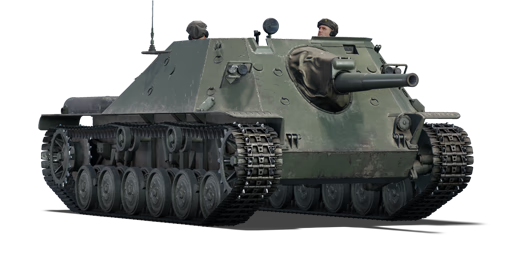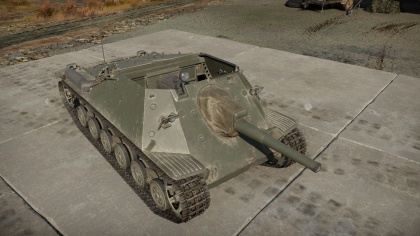Difference between revisions of "Ikv 72"
(→Survivability and armour) (Tag: Visual edit) |
(→Optics) (Tag: Visual edit) |
||
| Line 142: | Line 142: | ||
|- | |- | ||
| '''42''' || 37 ''(+5)'' || 31 ''(+11)'' || 16 ''(+26)'' || 1 ''(+41)'' || No | | '''42''' || 37 ''(+5)'' || 31 ''(+11)'' || 16 ''(+26)'' || 1 ''(+41)'' || No | ||
| − | |||
| − | |||
| − | |||
| − | |||
| − | |||
| − | |||
| − | |||
| − | |||
| − | |||
| − | |||
| − | |||
| − | |||
| − | |||
| − | |||
| − | |||
| − | |||
|- | |- | ||
|} | |} | ||
Revision as of 21:35, 20 July 2020
Contents
Description
The Infanterikanonvagn 72 is a rank Swedish tank destroyer
with a battle rating of (AB), (RB), and (SB). It was introduced in Update 1.97 "Viking Fury".
General info
Survivability and armour
With a maximum frontal armour thickness of 18.5 mm, the Ikv 72 has nearly no armour to speak of. The side armour is almost negligible, and can be penetrated by even rifle-calibre machine guns at point blank ranges. Aircraft are particularly deadly, as the vehicle has an open-topped crew compartment, and what little roof armour there is is only 5 mm thick at most.
The crew compartment is very cramped, and any hit by a large shell is liable to disable multiple crew members, if not all of them, simultaneously.
| Armour | Front (Slope angle) | Sides | Rear | Roof |
|---|---|---|---|---|
| Hull | 18.5 mm (42°) Upper Glacis
12 mm (28°) Lower Glacis 12 mm (37°) Front Sides |
7 mm Upper
6 mm Lower 6 mm Engine Compartment |
12 mm Lower
5 mm Engine Compartment |
0 mm Crew Compartment
4 mm Rear |
| Turret | 18.5 mm (Various Angles) Gun mantlet | N/A | N/A | N/A |
Mobility
| Game Mode | Max Speed (km/h) | Weight (tons) | Engine power (horsepower) | Power-to-weight ratio (hp/ton) | |||
|---|---|---|---|---|---|---|---|
| Forward | Reverse | Stock | Upgraded | Stock | Upgraded | ||
| Arcade | Expression error: Unexpected * operator. | 206 | Expression error: Unexpected round operator. | __.__ | |||
| Realistic | 128 | Expression error: Unexpected round operator. | __.__ | ||||
The Ikv 72 trades armour for mobility, boasting an excellent power/weight ratio and a high top speed of around 60 km/h. This allows it to easily get to good positions where it can put its powerful gun to best use. A high reverse speed also allows it to easily back off, and is particularly valuable when fighting in hull-down positions, where it can use its excellent gun depression to its advantage.
Armaments
Main armament
The Ikv 72 is armed with the 7,5 cm kan m/41, a rather conventional quick-firing 75 mm field gun. It starts off with the unremarkable slpprj m/40 uncapped AP shot, which is adequate against most opposition it may encounter but tends to suffer ricochets against sloped armour. However, once upgraded, the gun may fire the slpgr m/39 uncapped APHE shell and the slpprj m/40B APBC shot. The former round has a very lethal 260 g TNT filler but tends to ricochet more and has less penetration, while the latter has better penetration and ricochets less, and is thus more useful in uptiers. It is recommended to carry a mixture of both APHE and APBC unless the Ikv 72 is top tier, in which case the APHE alone is sufficient.
The gun also has an outstanding ±20° of gun elevation, allowing the Ikv 72 to take advantage of hull down positions that most other tanks cannot.
| 75 mm Kan m/41 | Turret rotation speed (°/s) | Reloading rate (seconds) | |||||||||||
|---|---|---|---|---|---|---|---|---|---|---|---|---|---|
| Mode | Capacity | Vertical | Horizontal | Stabilizer | Stock | Upgraded | Full | Expert | Aced | Stock | Full | Expert | Aced |
| Arcade | 42 | ±20° | ±10° | N/A | 7.0 | __._ | __._ | __._ | __._ | 7.6 | _._ | _._ | _._ |
| Realistic | 4.8 | __._ | __._ | __._ | __._ | ||||||||
Ammunition
| Penetration statistics | |||||||
|---|---|---|---|---|---|---|---|
| Ammunition | Type of warhead |
Penetration @ 0° Angle of Attack (mm) | |||||
| 10 m | 100 m | 500 m | 1,000 m | 1,500 m | 2,000 m | ||
| sgr m/40 | HE | 9 | 9 | 9 | 9 | 9 | 9 |
| slpgr m/39 | APHE | 63 | 61 | 53 | 44 | 37 | 31 |
| slpprj m/40 | AP | 85 | 83 | 74 | 64 | 55 | 48 |
| slpprj m/40B | APBC | 85 | 82 | 73 | 63 | 54 | 46 |
| Shell details | |||||||||
|---|---|---|---|---|---|---|---|---|---|
| Ammunition | Type of warhead |
Velocity (m/s) |
Projectile Mass (kg) |
Fuse delay (m) |
Fuse sensitivity (mm) |
Explosive Mass (TNT equivalent) (g) |
Ricochet | ||
| 0% | 50% | 100% | |||||||
| sgr m/40 | HE | 570 | 6.43 | 0.4 | 0.5 | 580 | 79° | 80° | 81° |
| slpgr m/39 | APHE | 580 | 6.5 | 1.2 | 9.0 | 260 | 47° | 60° | 65° |
| slpprj m/40 | AP | 580 | 6.6 | N/A | N/A | N/A | 47° | 60° | 65° |
| slpprj m/40B | APBC | 590 | 6.3 | N/A | N/A | N/A | 48° | 63° | 71° |
| Smoke shell characteristics | ||||||
|---|---|---|---|---|---|---|
| Ammunition | Velocity (m/s) |
Projectile Mass (kg) |
Screen radius (m) |
Screen deploy time (s) |
Screen hold time (s) |
Explosive Mass (TNT equivalent) (g) |
| rökgr m/22 | 496 | 6.6 | 13 | 5 | 20 | 8 |
Ammo racks
| Full ammo |
1st rack empty |
2nd rack empty |
3rd rack empty |
4th rack empty |
Visual discrepancy |
|---|---|---|---|---|---|
| 42 | 37 (+5) | 31 (+11) | 16 (+26) | 1 (+41) | No |
Usage in battles
The Ikv 72 excels at fighting from hull down positions, using its outstanding 20 degrees of gun depression and high reverse speed to limit exposure when taking shots. The high reverse speed also helps in city fighting when it has to quickly retreat after taking a shot. It is fast enough to keep up with even light tanks and can use this to take up unexpected positions from which to strike at the enemy.
Modules
| Tier | Mobility | Protection | Firepower | ||
|---|---|---|---|---|---|
| I | Tracks | Parts | Horizontal Drive | ||
| II | Suspension | Brake System | FPE | Adjustment of Fire | rökgr m/22 |
| III | Filters | Crew Replenishment | Elevation Mechanism | slpgr m/39 | |
| IV | Transmission | Engine | slpprj m/40B | ||
Pros and cons
Pros:
- Outstanding gun depression (-20°)
- Relatively fast rate-of-fire
- Excellent forward and reverse speeds
- Highly effective APHE shell with a large explosive filler
- Small target size, especially at long range
- Ammo is stored very safely, will get only ammoracked by artillery or by direct hits
Cons:
- Extremely vulnerable to aircraft
- Nearly no armour to speak of
- Must choose between high penetration APBC or high damage APHE
- Cramped crew compartment
- Low shell velocities inhibit use as a sniper
History
The Infanterikanonvagn 72 was a project started in 1949 by Sweden for an assault gun. The intended role of this vehicle was to support the infantry in the attack, replacing towed artillery guns. The design was to be small, and of light weight, around 6 tons. This was to reduce costs so a larger amount could be produced. The first prototype from Landsverk, completed in 1950, was armed only with three machine guns. This was insufficient, and it was re-armed with a 75 mm cannon, the same gun from the Strv m/42. It was a small, lightly armored vehicle, with a casemate superstructure housing the 75 mm gun. It had a crew of 4, and it was open topped. The Ikv 72 was later upgraded to the Ikv 102 and Ikv 103 standards, receiving an armored roof for the crew compartment, a 105 mm gun, and other improvements. The design weighed about 8 tons.
Media
Excellent additions to the article would be video guides, screenshots from the game, and photos.
See also
Links to the articles on the War Thunder Wiki that you think will be useful for the reader, for example:
- reference to the series of the vehicles;
- links to approximate analogues of other nations and research trees.
Bibliography
- GlobalSecurity.org. (n.d.). Infanterikanonvagn 72 / 102 / 103. GlobalSecurity.org. https://www.globalsecurity.org/military/world/europe/ikv-72.htm
- Infanterikanonvagn 72. (2020, May 14). In Wikipedia. https://en.wikipedia.org/w/index.php?title=Infanterikanonvagn_72&oldid=956568359
External links
Paste links to sources and external resources, such as:
- topic on the official game forum;
- encyclopedia page on the tank;
- other literature.
| Sweden tank destroyers | |
|---|---|
| Strv m/41 derivatives | Spj fm/43-44 · Sav m/43 (1944) · Sav m/43 (1946) · Pvkv II · Pvkv III |
| Ikv 72/103 | Ikv 72 · Ikv 103 |
| Pvkv m/43 | Pvkv m/43 (1946) · Pvkv m/43 (1963) |
| ATGM | UDES 33 · Pbv 302 (BILL) · Pvrbv 551 |
| Other | SAV 20.12.48 · Bkan 1C |
| Norway | VIDAR |





